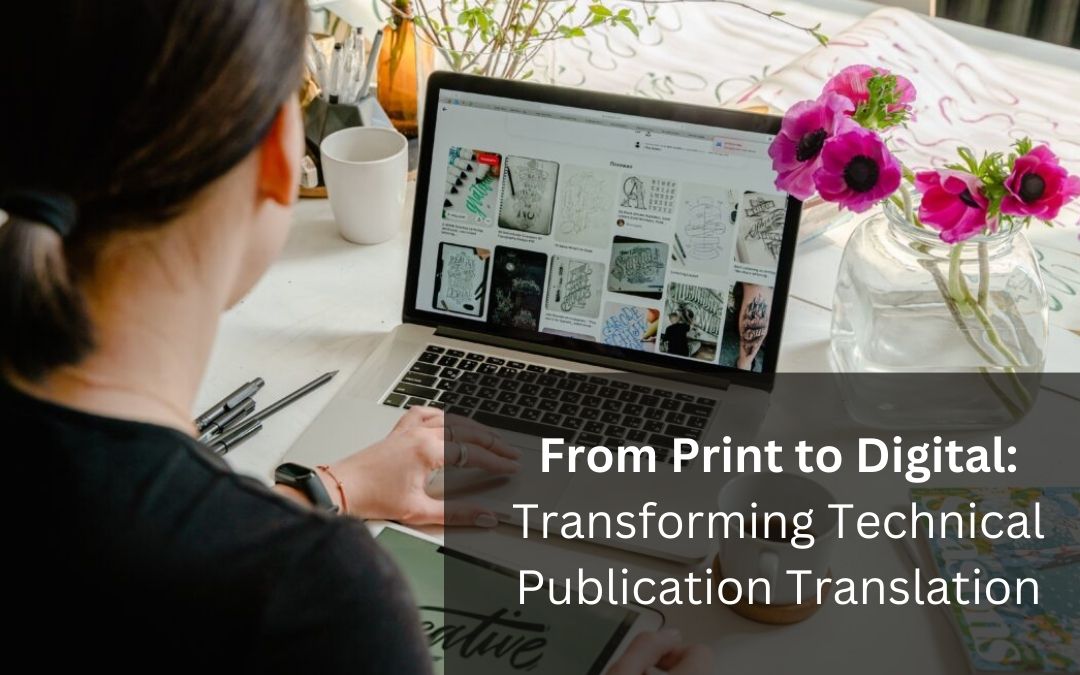In the age of digital transformation, technical publications are undergoing a profound shift. Gone are the days of thick printed manuals dominating workspaces. Instead, technical documents are embracing digital formats that offer unparalleled advantages in terms of accessibility, updates, and global reach. In this blog post, we will explore the first eight key aspects of this transformation and the role of translation in adapting to these changes.
1. Introduction to Digital Transformation
The digital age has reshaped how businesses operate and communicate. This extends to technical publications, which have transitioned from static print formats to dynamic digital documents accessible on various devices. This shift reflects the demand for real-time information and user-friendly interfaces in today’s fast-paced world.
2. The Role of Technical Publications
Technical publications are the lifeblood of industries like manufacturing, engineering, and technology. They provide critical information on product assembly, operation, and maintenance. Traditionally, these documents were printed and often presented challenges in terms of distribution, updates, and global dissemination.
3. Challenges of Traditional Print Publications
Printed technical publications posed several limitations. They were static, challenging to update, and costly to distribute internationally. This hindered accessibility and timely access to crucial information, often impacting efficiency and safety in industries where precision is paramount.
4. Digitalization of Technical Publications
The digitalization of technical publications involves converting static print documents into dynamic digital formats. These formats include PDFs, web-based platforms, and interactive documents that are easily accessible across devices. This transformation enables companies to overcome the constraints of print and adapt to the digital age’s demands.
5. Global Reach and Localization
Digital publications have the advantage of global reach. Companies can instantly disseminate information to employees, partners, and customers worldwide. However, to effectively engage international audiences, localization is essential. Translating and adapting digital content ensures that it resonates with diverse cultures and languages.
6. Benefits of Digital Technical Publications
Digital technical publications offer numerous benefits. They allow for real-time updates, reducing the risk of outdated information. Multimedia elements, such as videos and animations, enhance understanding. Interactive features, such as hyperlinks and search functionality, facilitate navigation and problem-solving.
7. Translation in the Digital Age
As technical publications go digital, translation becomes a critical component of their global success. Translating digital content requires linguistic expertise, technical knowledge, and an understanding of the digital platform’s capabilities. It involves more than text; it encompasses multimedia elements, user interfaces, and user experiences.
8. Challenges of Translating Digital Publications
Translating digital technical content presents unique challenges. Multimedia elements like videos and animations must be translated or subtitled. User interfaces must accommodate varying text lengths while remaining user-friendly. Cultural nuances must be considered to ensure that the translated content is culturally sensitive and resonates with the target audience.
9. Machine Translation and AI
In the digital age, machine translation and artificial intelligence (AI) technologies are increasingly used to streamline the translation of technical publications. Machine translation tools can quickly produce translations for initial comprehension, but they often require human post-editing to ensure accuracy and technical precision. AI-powered content management systems can assist in maintaining consistency and updating translations across digital platforms.
10. Human Expertise in Translation
While machine translation and AI offer efficiency, they cannot replace the expertise of human translators, particularly for complex technical content. Human translators bring domain knowledge, cultural awareness, and linguistic precision to ensure that the translated material maintains its technical accuracy and user-friendliness.
11. Localization of User Interfaces
Digital technical publications often include user interfaces, which require careful translation and localization. User interface elements like buttons, menus, and dialog boxes need to be adapted to the target language and culture. This involves considering text expansion or contraction and ensuring that the user experience remains seamless.
12. Interactive Training and E-Learning
Digital technical publications often incorporate interactive training modules and e-learning components. These modules aim to provide users with hands-on experience and knowledge. Translating and adapting these interactive elements for global training purposes requires expertise in both the technical subject matter and instructional design.
13. Maintaining Consistency Across Platforms
In the digital age, technical content is often disseminated across various digital platforms, including websites, mobile apps, and e-learning portals. Maintaining consistency in terminology, style, and branding across these platforms is crucial to ensure a unified user experience. Translation memory tools and glossaries play a significant role in achieving this consistency.
14. Accessibility and Inclusivity
Digital technical publications should prioritize accessibility and inclusivity. This involves making content accessible to individuals with disabilities, such as providing screen reader compatibility and alternative text for images. Ensuring that all users can access and benefit from the translated content is not only ethical but also a legal requirement in many jurisdictions.
15. Case Studies: Successful Digital Publication Translations
Illustrating success stories is valuable for understanding how businesses have effectively translated digital technical content for global markets. Case studies can showcase strategies, challenges, and outcomes, offering practical insights for others embarking on similar journeys.
16. Future Trends in Digital Publication Translation
The digital landscape is continuously evolving. Future trends in digital publication translation may include advancements in AI-driven content management, augmented reality integration for enhanced training experiences, and improved machine translation capabilities. Staying informed about these trends is essential for businesses looking to remain competitive and efficient.
17. Conclusion: Navigating the Digital Translation Landscape
In conclusion, the digital transformation of technical publications represents a dynamic shift that empowers industries to operate more efficiently and reach global audiences seamlessly. As technical content goes digital, the fusion of technology, translation expertise, and accessibility is reshaping how information is created, shared, and understood across borders. Adapting to the digital age involves embracing the potential of interactive, multimedia-rich content while maintaining precision and cultural sensitivity through expert translation and localization. Businesses that master this transition are well-positioned to thrive in the digital landscape, offering valuable knowledge and training experiences to diverse audiences worldwide.
[wpforms id=”3801″ title=”true” description=”true”]

